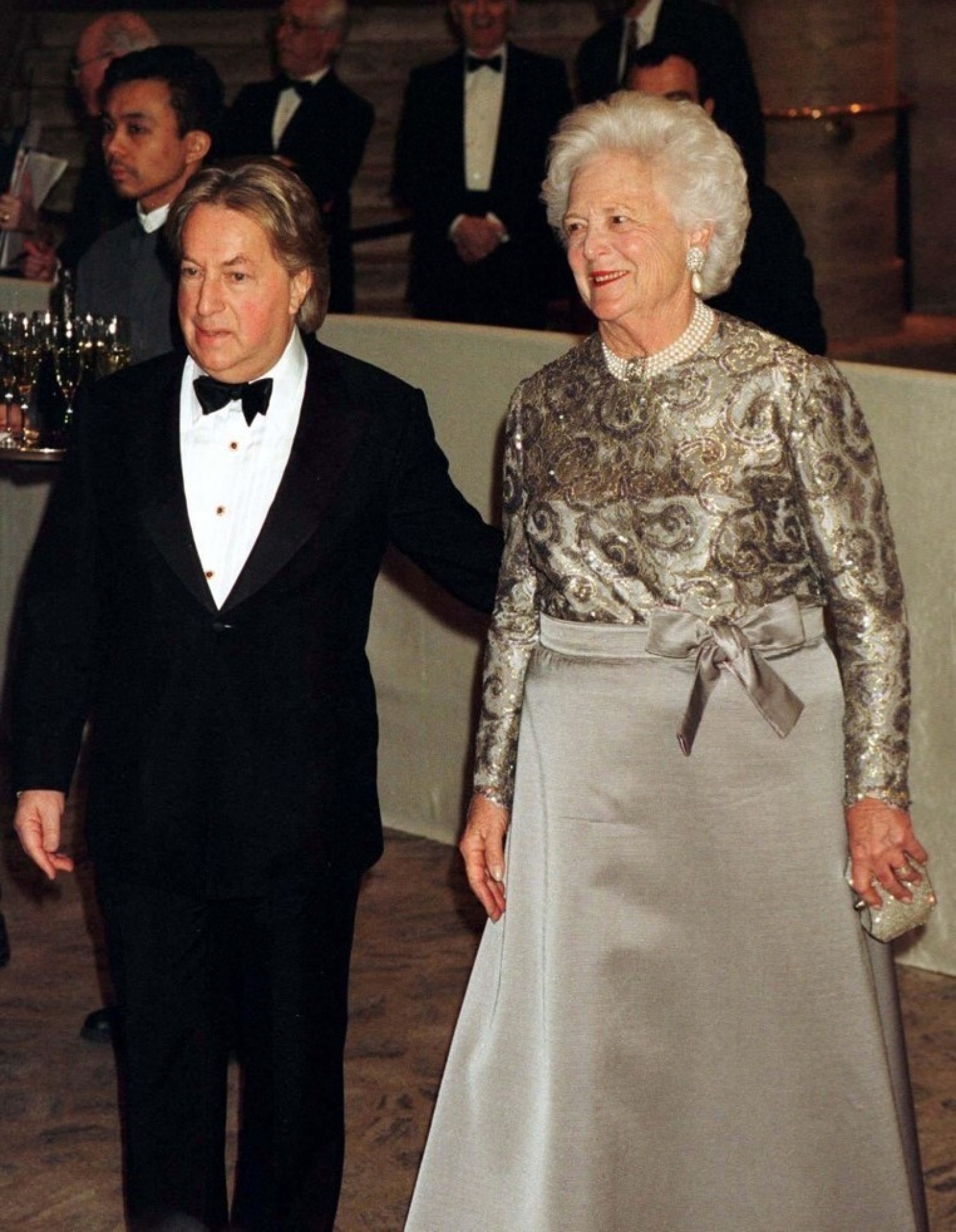
Designer Arnold Scaasi and his most famous client, first lady Barbra Bush, at the Council of Fashion Designers of America gala in 1997 where he received a Lifetime Achievement award. (Reutoers Photo: Mike Segar)
Over the course of a career that lasted more than 50 years, designer Arnold Scaasi dressed both first ladies and celebrities and his greatest skill may very well have been in never blurring the line between the two very different kinds of fame. Scaasi, 85, died early Tuesday morning in New York, according to family friend Michael Selleck. The cause of death was cardiac arrest.
Scaasi began his fashion career in the 1950s, when Seventh Avenue was still dominated by blue-collar garment workers and the seasonal wardrobes of society’s most influential ladies were dictated by the aesthetics of Paris. Scaasi, who was born Arnold Isaacs in Montreal, studied in Paris and apprenticed with the New York-based couturier Charles James.
He was tutored in the notion that dresses are designed and built — a kind of exoskeleton that flattered and framed a woman’s body. His clothes shaped and molded. They worked. They did not simply hang. That was the Parisian way. But he built his business in New York and thrived in both the rollicking milieu of entertainers and the fussy, just-so realm of politicians and socialites.
He was a shrewd showman, one who was enamored with fringe, beads and adornment. And he was in his full theatrical glory in 1969 when he created a sheer, bell-bottom pantsuit for Barbra Streisand to wear to that year’s Academy Awards. It remains one of the most infamous ensembles in Oscar history. The scrim of sparkling black fabric briskly articulated the inextricable and powerful link between fame and fashion. And it helped set a precedent for stars using style to provoke a cultural conversation in which they are the central subject.
Scaasi dressed a long list of celebrities, from Elizabeth Taylor and Aretha Franklin to Joan Rivers and Ivana Trump. But he wasn’t besotted with revealing skin. Near nudity was not his primary passion. His clothes were for making grand entrances swaddled in bold colors, feathers and beads and they were perfect for those women whose glory days were in the 1980s when flamboyance, “Dynasty” and “Dallas” defined glamour.
At heart, Scaasi believed in the glory of a woman’s beauty. She should be a dazzling bird-of-paradise. The designer was not edgy or cool, which is to say that he avoided austere black, saw no advantage in unfinished hems and sloppiness was, for him, not a symbol of intellectualism but laziness. Dressing up was a matter of being present, aware, relevant.
His first visit to the White House was at the invitation of Mamie Eisenhower. “As I remember it, the first dress I designed for Mrs. Eisenhower was a white chiffon with panels of leaf green floating from the waist,” Scaasi wrote in an essay for the Washington Post in 1997. “Mrs. Eisenhower was a pretty woman with beautiful skin, and she loved dressing up. She would always say: ‘Mr. Scaasi, remember that the skirt must be able to move easily — as you know, I love to dance!’ Her fittings were all done in the White House, in a bedroom on the second floor that has since become the family dining room.”
Scaasi designed evening gowns and day dresses for Jackie Kennedy and Lady Bird Johnson, but his most enduring and renowned relationship was with first lady Barbara Bush. She wore his cobalt-blue velvet and satin gown to the inaugural balls and made such a splash that the media dubbed her the glamorous grandmother. The dress was one of countless ensembles that Scaasi designed for Mrs. Bush and he was by her side when she donated her inaugural gown to the Smithsonian’s Museum of American History.
Years later, he created a wardrobe for Laura Bush when, as first lady, she traveled through Europe in 2001. Scaasi was surprised that Laura Bush would turn to her mother-in-law’s dressmaker, particularly since she already had a favored designer from her days in the Texas governor’s mansion. But Scaasi had spent decades honing his expertise at creating public, politically-correct, tasteful, photogenic wardrobes. He may not have been the most creative or dynamic choice; but he was reassuring. “I make very feminine, pretty clothes,” he told the Washington Post in 2001. “If you don’t want those kinds of clothes, don’t come to me.”



Arnold Scaasi, a most loved First Woman fashioner. The blog wonderfully praises his heritage and commitments to mold. Your ardent words catch the substance of his effect on style and polish. A piercing and conscious reverence to a plan light.